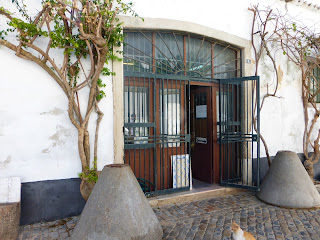We recently spent a
month traveling through Portugal with a side trip to Santiago de
Compostela, Spain. This is the first in my series of a vintage
journey to the far western corner of Europe....
As we started our Sunday morning walk through the walled city of Faro, located in the Algarve region of southern Portugal, we noticed a few people coming out of an old building and decided to peak in. It was a shop filled with brightly colored tiles (called azulejos in Portuguese) that
 |
| TILE SHOP STAIRCASE |
 |
| VINTAGE TILES ON DISPLAY |
We were there on a
Sunday, when all the other stores were closed. I expect that this
tile store was opened per a special customer request because it was
closed when we walked by later. The place was unique in that there
was not a visible name or obvious store front. It was located on a
street called Rua da Porta Nova in the old city.
 |
| TILED PANEL 16TH CENTURY |
As we were leaving Faro that day we noticed an old abandoned building that had been stripped of its tiles. This made me wonder if tile theft had become a concern in Portugal. It turns out that over the last 20 years there have been massive losses due to theft and lack of conservation. However, efforts of the recently organized project, “S.O.S. Azulego,” have cut the theft by 80% and increased regulations to help prevent the demolition of the tile covered building facades.
 |
| TILED WORK OF ART ON PRIVATE HOME |
They can be seen on entire walls of churches in immense religious scenes and in geometric patterns on walls of homes. They frequently portray scenes from the history of the country or simply serve as street signs or house number. Although they are not a Portuguese invention (the use of glazed tiles began in Egypt), they have been used more imaginatively and consistently in Portugal than in any other nation.
 |
| AZULEJOS FACADE IN AVEIRO |
.




